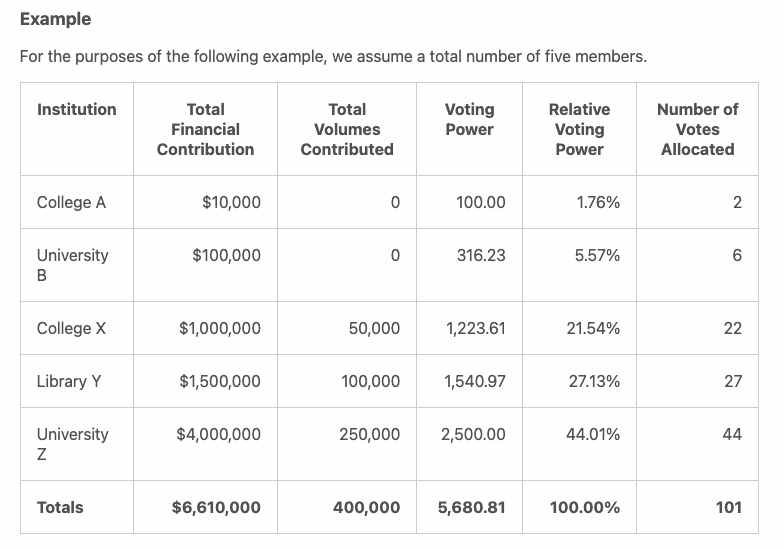Explanation of Weighted Voting
HathiTrust’s bylaws state:
For the purposes of Member voting, HathiTrust employs a weighted voting to reflect the level of member investment in HathiTrust. This system ensures that each Member has a vote that is weighted according to a published formula approved by the Board of Governors. (Article III, Section 3 – Voting Rights)
Weighted voting ensures that the members’ stake in governance is related to the degree of investment in and contributions to HathiTrust. The model employed seeks to ensure that both new members and long-standing members have their voices heard. Voting weights are periodically re-calculated. They are always updated within one month of any event requiring a vote of the full membership.
| Steps | Formula |
| 1. Calculate Voting Power (V) for each member. A Voting Power (VP) for each institution is calculated by taking the square root of the member's total financial contributions (fees) to date, plus the square root of the total volumes deposited to date. | VP = (square root of total volumes deposited + (Square root of total financial contribution) |
| 2. Determine Relative Voting Power (RVP) for each member. Each member's VP value is divided by the sum total of all member VPs and converted to a percentage. | RVP = (VP / sum of all voting power) |
| 3. The RVP is rounded to nearest positive whole number to get the final number of votes allocated. | Examples: 0.3% is rounded up to 1 4.2% is rounded down to 4 |
| RVP values less of than 1% of the total are rounded up to ensure that all members get at least one vote |
It is important to note that although the sum of all Voting Power values would equal 100%, more than 100 votes are allocated to the entire membership because of the rounding up that occurs in the final step.
Example
For the purposes of the following example, we assume a total number of five members.

View this table as a spreadsheet with formulas. View Current Weighted Votes of all members (as of August 31, 2019).
How the Institutional Weighted Voting Process Was Developed
In 2009, at the request of the HathiTrust Executive Committee, staff at the University of Michigan conducted research into effective multi-party voting models. Among the factors to be considered were elements that might be indicative of the level of investment in the enterprise, such as duration of participation, role in establishing HathiTrust, the number of volumes contributed, and financial contributions. Based on this work, the Executive Committee developed a model based on direct financial contributions (excluding resources-in-kind), and volumes in the repository. This method was first employed at the HathiTrust Constitutional Convention in 2011.
A full discussion of the rationale behind weighted voting models and the approach is online.